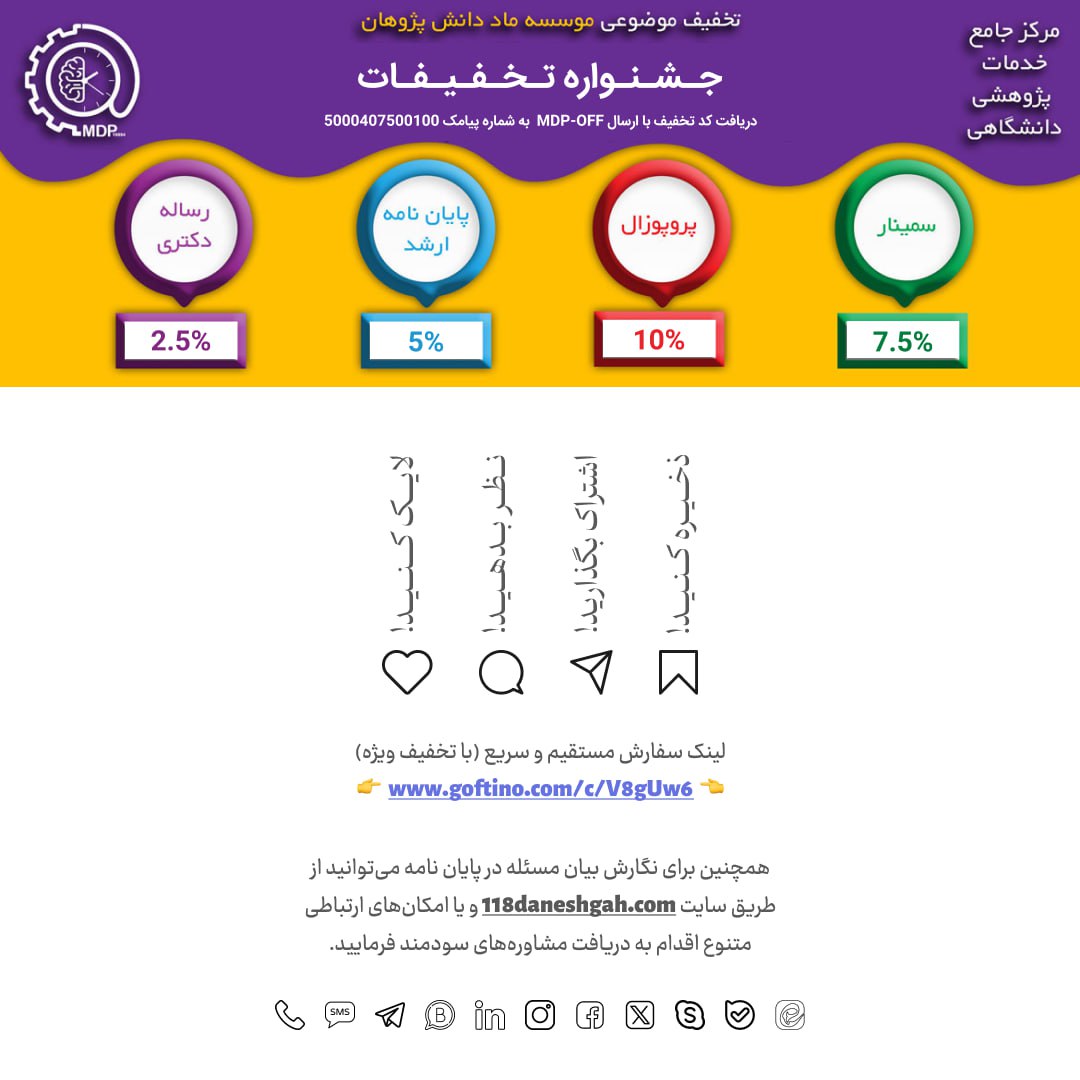- موضوعات پیشنهاد شده برای پایان نامه رشته مدیریت بانکداری:
- رابطه کارآفرینی سازمانی و عملکرد بانک ها
- بررسی رابطه شهرت حسابرس و مدیریت سود در صنعت بانکداری
- ارزیابی سرمایه فکری در صنعت بانکداری و ارتبط آن با عملکرد بانک ها
- بررسی رابطه تنوع پرتفوی وام های اعطایی با ریسک در سیستم بانکی
- بررسی رابطه تنوع پرتفوی وام های اعطایی با کارایی در سیستم بانکی
- بررسی رابطه تنوع پرتفوی وام های اعطایی با سرمایه گذاری در سیستم بانکی
- بررسی رابطه شهرت بانک ها و نیات رفتاری مشتریان (نقش شناخت، اعتماد و تعهد)
- رابطه قابلیت های سازمانی و عملکرد سیستم هزینه یابی بر مبنای هدف
- طراحی مدلی جهت مکان یابی بهینه شعب بانک با استفاده از روش تحلیل سلسله مراتبی فازی
- بررسی تاثیر خصوصی سازی بر مدیریت سود بانک ها (مطالعه موردی بانک …)
- بررسی رابطه بین مدیریت سود و کیفیت سود بانک ها (مطالعه موردی بانک …)
- بررسی رابطه ویژگی های کیفی سود (پایداری سود، قابلیت پیش بینی سود، به موقع بودن سود، محافظه کار بودن سود و مربوط بودن سود به ارزش سهام) با عملکرد شرکت ها
- بررسی رابطه سرمایه در گردش و سودآوری بانک ها
- بررسی رابطه سرمایه در گردش و بازده سهام بانک های بورسی
- شناسایی و اولویت بندی عوامل موثر بر پیاده سازی موفق مدیریت ارتباط با مشتری CRM در صنعت بانکداری
- طراحی مدل بهینه مدیریت الکترونیکی روابط با مشتریان (ECRM) در بانک ها
- ارائه مدلی جهت سنجش و کمی سازی ارزش ویژه برند در صنعت بانکداری
- بررسی عوامل موثر بر ارزش ویژه برند در صنعت بانکداری
- بررسی رابطه ارزش ویژه برند و عملکرد بانک ها
- رتبه بندی اعتباری مشتریان با استفاده از ابزار داده کاوی
- محاسبه نرخ تمرکز صنعت بانکداری (بانک های دولتی و خصوصی) و بررسی ارتباط آن با سودآوری بانک ها
- بهینه سازی مدیریت ارتباط با مشتری (CRM) با استفاده ار تکنیک داده کاوی
- پیش بینی میزان سپرده های بانک با استفاده از روش شبکه عصبی و آریما و مقایسه نتایج
- بررسی تاثیر ریسک های بانکی (عملیاتی،اعتباری، نقدینگی و بازار) بر عملکرد بانک های کشور
- ارزیابی عملکرد بانک ها از بعد ریسک اعتباری با مدل DEA
- شناسایی و رتبه بندی شاخص های موفقیت اجرای مدیریت دانش بانک با استفاده از مدل PLS
- ارزیابی عملکرد مدیریت دانش با استفاده از AHP (یا AHP فازی)
- بررسی رابطه مدیریت دانش و متغیرهای محیطی سازمان با ساختار سازمانی (موردی بانک …)
- بررسی رابطه استراتژی های مدیریت دانش و عملکرد (موردی بانک …)
- تدوین استراتژی بهینه منابع انسانی (موردی بانک …)
- بررسی رابطه بین سبک های مدیریت تعارض و کارایی و اثربخشی سازمان (موردی بانک …)
- بررسی رابطه بین سبک های مدیریت تعارض و فرهنگ سازمان (موردی بانک …)
- بررسی رابطه بین سبک های مدیریت تعارض و تعهد سازمان (موردی بانک …)
- شناسایی و اولویت بندی استراتژی های توانمندسازی منابع انسانی (موردی بانک …)
- بررسی رابطه بین توانمندسازی منابع انسانی و اثربخشی سازمان (موردی بانک …)
- بررسی رابطه بین توانمندسازی منابع انسانی و فرهنگ سازمان (موردی بانک …)
- بررسی رابطه بین توانمندسازی منابع انسانی و تعهد سازمان (موردی بانک …)
- بررسی رابطه بین توانمندسازی منابع انسانی و کارایی سازمان (موردی بانک …)
- رابطه شهروندی سازمانی با سودآوری (موردی بانک …)
- رابطه عدالت سازمانی با سودآوری (موردی بانک …)
- رابطه شهروندی سازمانی و عملکرد سازمان (موردی بانک …)
- رابطه مدیریت مشارکتی و فرهنگ سازمانی (موردی بانک …)
- مدیریت مشارکتی و اثربخشی و کارایی سازمانی (موردی بانک …)
- ارزیابی عملکرد منابع انسانی با رویکرد کارت امتیازی متوارن BSC
- بررسی عوامل موثر در حفظ پایداری منابع انسانی
- بررسی ارتباط کیفیت گزارشگری مالی و تصمیم گیری مدیران
- بررسی رابطه ویژگی های کیفی سود (پایداری سود، قابلیت پیش بینی سود، به موقع بودن سود، محافظه کار بودن سود و مربوط بودن سود به ارزش سهام) با عملکرد (موردی بانک …)
- ارزیابی سرمایه فکری در صنعت بانکداری و ارتباط آن با عملکرد بانک ها
- رابطه قابلیت های سازمانی و عملکرد سیستم هزینه یابی بر مبنای هدف
- تبیین رابطه کارایی و عملکرد (بازده) سهام بانک های خصوصی
- طراحی مدل های جدید (E-S-Qual) و (E-RecS-Qual) جهت سنجش کیفیت خدمات بانکداری اینترنتی
- طراحی مدل تلفیقی کارت امتیازی متوازن (BSC) و تصمیم گیری چندمعیاره فازی (FMADM) جهت ارزیابی عملکرد سیستم بانکی
- طراحی مدل تلفیقی کارت امتیازی متوازن (BSC) و تحلیل شبکه ای (ANP) جهت ارزیابی عملکرد مدیریت دانش سیستم بانکی
- Optimal Inflation Targets and the Role of the Central Bank in Albania Loan Loss Provisioning in the Commercial Banking System of Barbados: Practices and Determinants
- Impact of Corporate Governance on Firm Performanc Evidence from the Tobacco Industry of Pakistan
- Impact of Audit Quality on Earnings Management
- Government Ownership and Performance of MalaysianGovernment-Linked Companies
- Financial Performance Evaluation of Some Selected Jordanian Commercial Banks
- Determinants of Dividend Policy of Banks in Ghana ()
- Acquisition Activities of Public Sector Banks in India and its Impact on Shareholders’ Wealth
- Determinants of Corporate Capital Structure Under Different Debt Maturities ()
- Factors Influencing the Profitability of Conventional Banks of Pakistan ()
- Impact of Audit Quality on Earnings Management ()
- The Effects of Bank Capital on Lending:What Do We Know, and What Does It Mean? ()
- The Impact of Corporate Governance on Auditor Choice ()
- The Impact of Organizational Culture on Knowledge Sharing: The Context of Jordan’s Phosphate Mines Company
- Loan Loss Provisioning in the Commercial Banking System of Barbados: Practices and Determinants ()
- Examining The Capital Structure Determinants: Empirical Analysis of Companies Traded on Abu Dhabi Stock Exchange ()
- Banking Crisis and Financial Stability in Nigeria ()
- The Impact of Working Capital Efficiency on Profitability– an Empirical Analysis on Jordanian Manufacturing Firms ()
- The impact of bank ownership concentration on impaired loans and capital adequacy ()
- Capital structure, equity ownership and firm performance
- Impact of intellectual capital on organisational performance ()
- Interest rates and bank risk-taking ()
- The effects of loan portfolio concentration on Brazilian banks’ return and risk ()
- Capital ratios and the cross-section of bank stock returns: Evidence from Japan ()
- Banks total factor productivity change in a developing economy: Does ownership and origins matter?
- The impact of taxation on bank profits: Evidence from EU banks
- Bank size, market concentration, and bank earnings volatility in the US
- The impact of management and board ownership on profitability in banks with different strategies
- Bank size and risk-taking under Basel II
- Capital requirements and bank behavior in the UK: Are there lessons for international capital standards?
- Modelling the effect of national culture on multinational banks’ performance: A conditional robust nonparametric frontier analysis
- Interest rates and bank risk-taking
- Bank monitoring, profit efficiency and the commercial lending business model
- Banks’ regulatory capital buffer and the business cycle: Evidence for Germany
- The effects of loan portfolio concentration on Brazilian banks’ return and risk
- Capital ratios and the cross-section of bank stock returns: Evidence from Japan
- Banks total factor productivity change in a developing economy: Does ownership and origins matter? The impact of taxation on bank profits: Evidence from EU banks
- Bank size, market concentration, and bank earnings volatility in the US
- The impact of management and board ownership on profitability in banks with different strategies
- Bank size and risk-taking under Basel II
- Capital requirements and bank behavior in the UK: Are there lessons for international capital standards?
- Modelling the effect of national culture on multinational banks’ performance: A conditional robust nonparametric frontier analysis
- Modelling the effect of national culture on multinational banks’ performance: A conditional robust nonparametric frontier analysis
- A Framework for Evaluating the Effectiveness of Information Systems at Jordan Banks: An Empirical Study
- A NOTE ON MANAGEMENT EFFICIENCY AND INTERNATIONAL BANKING. SOME EMPIRICAL PANEL EVIDENCE
- Accounting and capital market measures of risk: Evidence from Asian banks during 1998–2003
- An Innovative Spreadsheet Authoring Environment
- Applying enhanced data mining approaches in predicting bank performance: A case of Taiwanese commercial banks
- Assessing output and productivity growth in the banking industry
- Assessing the efficiency in operations of a large Greek bank branch network adopting different economic behaviors
- Asset prices and banking distress: A macroeconomic approach
- Auditor reputation and earnings management: International evidence from the banking industry
- Bank ownership type and banking relationships
- Bank stock returns and economic growth
- Banking crisis and productivity of borrowing firms: Evidence from Japan
- Corporate choice of banks: Decision factors, decision maker, and decision process
- Demand estimation and consumer welfare in the banking industry
- Differential impact of Korean banking system reforms on bank productivity
- Does bank ownership increase firm value? (Evidence from China)
- Entrepreneurial finance: Banks versus venture capital
- Evaluating the state of competition of the Greek banking industry
- Financial reforms and time-varying microstructures in emerging equity markets
- How to Gauge the Credit Risk of Bank Loans: Evidence from Taiwan
- Information asymmetry and the value of cash
- Internet Banking Adoption Among Young Intellectuals
- INTERNET BANKING IN INDIA-A STEP TOWARDS FINANCIAL INCLUSION
- Ownership Structure, Risk and Performance in the European Banking Industry
- Risks in Large Value Payment Systems
- The Analysis of Taiwanese Bank Efficiency: Incorporating both External Risk and Internal Risk
- The Economics of Islamic Finance and Securitization
- The effects of reform on China’s bank structure and performance
- The impact of regulatory reforms on cost structure, ownership and competition in Indian banking
- The Influence of Trust on Internet Banking Acceptance
- What determines the banking sector performance in globalized financial markets? The case of Turkey
- A comprehensive analysis of the effects of risk measures on bank efficiency: Evidence from emerging Asian countries
- A fuzzy MCDM approach for evaluating banking performance based on Balanced Scorecard (2009)
- A genetic programming model for bankruptcy prediction: Empirical evidence from Iran (2009)
- An evaluation of alternative scoring models in private banking (2009)
- Association of DEA super-efficiency estimates with financial ratios: Investigating the case for Chinese banks
- Bank modelling methodologies: A comparative non-parametric analysis of efficiency in the Japanese banking sector
- Bank ownership and executive perquisites: New evidence from an emerging market
- Bank ownership reform and bank performance in China
- Bankruptcy prediction in banks and firms via statistical and intelligent techniques-a review
- Benchmarking firm performance from a multiple-stakeholder perspective with an application to Chinese banking
- Comparing the performance of market-based and accounting-based bankruptcy prediction models
- Cost efficiency, economies of scale, technological progress and productivity in Indonesian banks
- Credit risk assessment with a multistage neural network ensemble learning approach
- Determinants of banks’ risk exposure to new account fraud – Evidence from Germany
- Efficiency analysis of cross-region bank branches using fuzzy data envelopment analysis
- Efficiency and stock performance of EU banks: Is there a relationship?
- Equity Ownership Structure, Risk-Taking and Performance: An Empirical Investigation in Turkish Companies
- First Financial Restructuring and Operating Efficiency: Evidence from Taiwan Commercial Banks
- Fuzzy performance evaluation in Turkish Banking Sector using Analytic Hierarchy Process and TOPSIS
- Genetic programming for credit scoring: The case of Egyptian public sector banks
- How loan portfolio diversification affects risk, efficiency and capitalization: A managerial behavior model for Austrian banks
- Intellectual Capital: Acquisition and Maintenance: The Case of New Zealand Banks
- Intellectual Capital: Acquisition and Maintenance: The Case of New Zealand Banks
- Managers and efficiency in banking
- Market structure, conduct and performance: Evidence from the Bangladesh banking industry
- Multiple goals and ownership structure: effects on the performance of Spanish savings banks
- Optimizing the Use of Information and Communication Technology (ICT) in Nigerian Banks
- pening the black box of efficiency analysis: an illustration with UAE banks
- Predicting Japanese bank stock performance with a composite relative efficiency metric: a new investment tool(
- The effect of capital wealth on optimal diversification: Evidence from the Survey of Consumer Finances
- The effects of focus versus diversification on bank performance: Evidence from Chinese banks
- The impact of bank ownership concentration on impaired loans and capital adequacy
- The impact of banking sector reform in a transition economy: Evidence from Kyrgyzstan
- The Impact of E-Commerce Security, and National Environment on Consumer adoption of Internet Banking in Malaysia and Singapore
- The impact of non-traditional activities on the estimation of bank efficiency: international evidence
- Using neural networks ensembles for bankruptcy prediction and credit scoring (2008)
- Managers and efficiency in banking
- Bank ownership type and banking relationships
- Does bank ownership increase firm value? Evidence from China
- Bank stock returns and economic growth
- Differential impact of Korean banking system reforms on bank productivity
- Market structure, conduct and performance: Evidence from the Bangladesh banking industry
- The effects of focus versus diversification on bank performance: Evidence from Chinese banks
- Efficiency and stock performance of EU banks: Is there a relationship?
- Assessing output and productivity growth in the banking industry
- Assessing the efficiency in operations of a large Greek bank branch network adopting different economic behaviors
- Auditor reputation and earnings management: International evidence from the banking industry
- Bank modelling methodologies: A comparative non-parametric analysis of efficiency in the Japanese banking sector
- Determinants of banks’ risk exposure to new account fraud – Evidence from Germany
- Efficiency analysis of cross-region bank branches using fuzzy data envelopment analysis
- Financial reforms and time-varying microstructures in emerging equity markets
- How loan portfolio diversification affects risk, efficiency and capitalization: A managerial behavior model for Austrian banks
- Intellectual Capital: Acquisition and Maintenance: The Case of New Zealand Banks
- Optimizing the Use of Information and Communicatio Technology (ICT) in Nigerian Banks
- Accounting and capital market measures of risk: Evidence from Asian banks during 1998–۲۰۰۳
- Asset prices and banking distress: A macroeconomic Approach
- Evaluating the state of competition of the Greek banking industry
- The impact of banking sector reform in a transition economy: Evidence from Kyrgyzstan
- The Impact of E-Commerce Security, and National Environment on Consumer adoption of Internet Banking in Malaysia and Singapore
- The impact of regulatory reforms on cost structure, ownership and competition in Indian banking
- The Influence of Trust on Internet Banking Acceptance
- What determines the banking sector performance in globalized financial markets? The case of Turkey
رشته های مقطع کارشناسی - پایان نامه ها - فرآیند استخراج مقاله از پایان نامه














